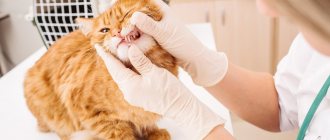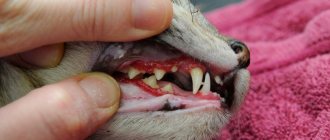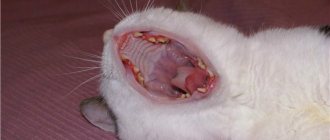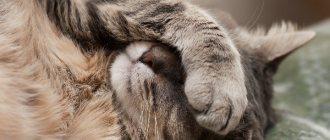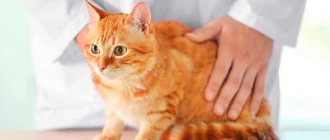If your cat has a swollen cheek under the eye for unknown reasons, and the swelling hurts when you press it, it is better not to wait for the situation to resolve on its own, but to take your four-legged friend to the veterinary clinic as soon as possible. There are various dental and other pathologies in which a neoplasm appears on the inside or outside, filled with pus or other pathological exudate. Therefore, in order for the treatment to be correct, it is important to find out an accurate diagnosis.
Tumor of the lower jaw in a cat: causes and treatment
Oral pathologies in cats are a rare occurrence.
Most often, old or weakened animals encounter neoplasms, inflammatory processes and bacterial lesions of the mouth and jaw. A tumor of the lower jaw in cats is difficult to treat at home and is difficult to diagnose, so you should consult a veterinarian.
The results of the X-ray examination will allow us to draw conclusions about the nature of the tumor.
Diseases of the teeth and oral cavity
If a cat's lower jaw is swollen, the likely cause is oral disease. In older cats we are talking about dental diseases. With age, teeth begin to loosen, lose hardness, and begin to crumble.
Any microcracks in the enamel lead to the development of a pathological process, which results in complete decay of the tooth.
In cats, the roots of the teeth are located deep in the gum tissue, so tooth decay can lead to the formation of a seal on the lower jaw. Associated symptoms:
- refusal to eat;
- jaw turned to one side;
- lethargy and weakness;
- no pain when pressed.
Typically, animals experiencing dental problems refuse to eat. At the same time, the cat experiences severe hunger and can in every possible way attract attention to its own bowl, but as soon as it is filled, the pet will turn away and leave. This is because chewing food causes pain.
The structure of the tumor will tell you about the possible causes. If a hard neoplasm is noticeable upon palpation, but the cat breaks out and does not allow itself to be touched, a cyst of the lower jaw is a possible cause. This neoplasm can be caused by dental diseases and is an overgrowth of bone tissue in the lower jaw.
If a soft and heterogeneous structure is noted upon palpation, the possible cause is an abscess, the development of which is due to the presence of pathogenic microorganisms in the oral cavity. This happens when pathogenic agents penetrate deeply into the root of the tooth. The abscess must be opened surgically, but there are cases when it breaks out on its own.
Possibly what could cause a cat's eyes to fester?
Diseases of the oral cavity and teeth in cats are indicated by foul breath, red gums and impaired jaw movement during eating.
This pathology can only be treated surgically - it is necessary to remove rotten teeth, open an abscess or cyst. If the abscess has opened on its own, antiseptic treatment should be carried out several times a day to avoid secondary infection of the wound cavity.
During surgical removal, the doctor must prescribe antibiotics to prevent infection of healthy oral tissues.
Malignant and benign neoplasms
Malignant tumors in the mouth of animals are rare. However, if the jaw of a cat over 13 years of age is swollen, cancer can only be ruled out after a comprehensive examination of the animal.
There are usually no specific symptoms for jaw cancer. The animal may become lethargic and refuse to eat, but these same signs accompany an abscess and dental problems.
To make an accurate diagnosis, it is necessary to take an X-ray of the jaw and take a blood test to identify the inflammatory process. If the presence of a tumor is confirmed, an operation is performed to remove it, followed by tissue examination.
For malignant neoplasms, animals are prescribed a course of chemotherapy.
The danger of malignant neoplasms is that they are rarely accompanied by significant symptoms. A jaw tumor at the beginning of development manifests itself in the same way as dental problems, but can cost the cat his life.
With osteosarcoma and squamous cell carcinoma of the jaw, pain is pronounced. The animal cannot chew, drink water, and does not allow the affected area to be touched. In some cases, syringe feeding may be necessary. It is important not to try to treat your pet on your own, but to visit a doctor in a timely manner.
Other reasons
Swelling of the lower jaw and lips in cats can be caused by household injuries. An older cat may accidentally scratch his lip when chewing hard food. As a result, it will swell and upon external examination it will appear that it is a swollen jaw.
Burns to which animals that like to chew wires or taste food on the stove are also susceptible. Despite the apparent harmlessness, household injuries should be treated.
Any wounds and injuries are treated with an antiseptic; for burns, you should use a special product to speed up healing.
Source: https://KozhaKoshek.com/opuhla-chelyust-u-kota.html
What are the causes of swelling?
Cats love to rub their faces against various objects, leaving their marks on them. Therefore, your pet may accidentally get hurt or get a splinter. A foreign body provokes inflammation, which causes swelling. A pet can hit its face during outdoor games and a hematoma occurs, in which bleeding occurs under the skin. Symptoms:
- painful swelling;
- unexpressed asymmetry of the muzzle;
- bloody crust if the skin is damaged;
- purulent discharge when the inflammatory process was not detected in a timely manner and the wound became infected.
Return to contents
Gingivitis covers the teeth and mucous membranes, spreading to the ligamentous apparatus and bone structures of the jaw. The main reasons for the development of the disease are a lack of vitamins A and C, the introduction of bones into the diet that injure the gums, the formation of tartar, severe viral diseases, and malocclusion when the teeth regularly damage the mucous membranes. Signs:
- profuse drooling;
- putrid odor from the mouth;
- redness and swelling;
- decreased appetite;
- loss of body weight.
Return to contents
Most often it occurs on the lips due to allergies of various etiologies. It appears as an ulcerative tumor or plaque and appears predominantly on one side of the muzzle. Unfavorable factors for the development of granuloma are helminthic infestation, skin parasites, food components, household chemicals, some types of indoor plants, fungus or mold in the room. Manifestation:
- the appearance of dense nodules and ulcers on the lip;
- swelling;
- absence of pain;
- decreased food and water intake, which causes the cat to lose weight and show signs of dehydration.
Return to contents
The causative agent is Staphylococcus aureus. Inflammation affects all bone structures and bone marrow of the lower jaw. The main factor in the development of osteomyelitis is considered to be advanced gingivitis, abscess, periodontal disease, wounds through which infection entered, and incorrectly performed dental procedures. In advanced cases, the cat will not live long. Symptoms:
- local and general hyperthermia;
- lethargy, refusal to play and eat;
- increased thirst;
- the appearance of a fistula on the jaw, from which pus is released;
- heart rhythm disturbance;
- enlargement of local lymph nodes;
- redness, swelling;
- the appearance of areas of necrosis.
Return to contents
According to veterinarian statistics, tumors of the mandibular joint and oral structures in cats account for 10% of the total number of pathological formations.
If your cat has a lump on his chin, it could be a benign or malignant tumor. Among non-oncological pathological formations, a cyst of the salivary glands - mucocele - is most often diagnosed. Due to injuries, a cavity is formed in which saliva accumulates. It is manifested by slight swelling, there is no pain. Mucocele is dangerous due to degeneration into cancer.
Among malignant neoplasms, the lower jaw is affected by sarcoma or squamous cell carcinoma, which are characterized by an aggressive course and rapid formation of metastases. Oncology occurs due to a failure of the cell cycle, when cells begin to rapidly divide and form a compaction. Most often, cancer is provoked by the owner’s smoking in the presence of a cat, decreased immunity, and chronic inflammation of the jaw bone. Cats with cancer live 3-12 months. A malignant tumor of the lower jaw manifests itself as follows:
- pronounced compaction that increases in size;
- salivation;
- the appearance of blood clots;
- sudden weight loss;
- strong pain;
- general deterioration of health.
Return to contents
Swelling of a cat's chin: the cause of inflammation. A lump appeared on the cat's chin
Sometimes owners may notice that the cat has a lump on his chin. It has the shape of a ball. Without examination and consultation with a veterinarian, it is very difficult to understand whether such a phenomenon will become a symptom of a dangerous disease or whether this sign is completely safe for the health of the pet.
To understand the reason why a cat's chin began to swell, you need to pay attention to the nature and size of this bump. The diagnosis will depend on this and, accordingly, treatment will be prescribed. The lump can be of several sizes :
- Small ones . Very often these are simple pimples. They can appear due to the lack of, as well as violation of personal hygiene by the cat. That is, for some reason the animal did not wash itself well. This causes the skin to lose its protective functions, resulting in clogged pores. To make the bumps go away, you need to cut the hair on the cat's chin and wipe the area with hydrogen peroxide several times a day.
- Average _ Their diameter ranges from 0.2 to 0.5 cm. Usually a lump of this size in a cat is called a subcutaneous boil. It develops like a pimple. If the owners did not promptly pay attention to the bump on the chin and did not treat it, then the pet’s condition may worsen. In addition to the increased size of the pimple, suppuration is added. In this case, you need to immediately take your pet to the veterinarian; piercing the boil yourself or waiting for it to go away is highly not recommended.
- Large ones . This may indicate the development of boils in a cat that were caused by subcutaneous parasites. Initially, the cone becomes red, but if the disease is severely neglected, it acquires a yellow or green tint. When touching boils, the cat experiences severe pain, so most often the animals simply do not give in to their hands. You should definitely contact your veterinarian quickly for help to prevent the infection from getting worse.
A lump on a cat's chin may be a normal lymph node. It must be palpable well. But this is still not the norm for the animal. Most likely, he had a weakened immune system or vitamin deficiency. To rid your cat of such a lump, you should change his lifestyle. For example, give up artificial food and return to natural food.
If a tumor appears on the chin of a domestic cat, it may be a malignant neoplasm, that is, cancer. This usually occurs in an old animal or after a serious illness.
In this case, the veterinarian prescribes emergency surgery.
It is almost impossible to cure cancer in a livestock, but after surgery there is a high probability that the cat will live in good health for many more years.
Causes of lumps on the chin of a pet
Every owner worries about the health of his cat and tries to prevent situations where the life or health of the pet is threatened. But it is simply impossible to always control and protect an animal. Therefore, sometimes situations occur that lead to a swollen cat’s chin. The reasons for the appearance of various bumps include :
- Acne . They can also be called blackheads. Inflammatory processes occur as a result of clogged pores on the pet’s skin. In addition, anke can be caused by poor-quality food or dishes of the animal. A plastic plate can absorb various germs that are not washed off with water. Here they are actively developing. The pet will constantly touch the dangerous place with the lower jaw, which will lead to the development of acne or blackheads. If treatment is not promptly addressed, a lump with abscesses or suppuration will appear on the chin.
- Insect bites . Usually they are bees or gadflies. In this case, the owner must give an antihistamine to his cat.
- Allergy . It is definitely worth analyzing what could have led to its formation and giving your pet allergy medication. This must be done quickly so that the animal does not get worse, as the reaction may go lower. For example, the neck.
- Abscess . Most often it occurs as a result of an insect bite. Accompanied by elevated temperature, apathy, and lethargic state of the animal. In addition, the abscess causes severe pain when touched, as well as the discharge of pus with ichor. Only a veterinarian can save a cat or cat from this disease. Moreover, this must be done surgically.
- Dental diseases.
- Neoplasms of various types.
It is better not to wait for a cat with a lump on the chin to get worse, but to immediately go to the vet when it is detected. He will examine the sick animal, make a diagnosis, according to which the correct treatment will be prescribed.
Source: https://kotemotel.ru/koshki/opuh-podborodok-u-koshki-prichina-vospaleniya-poyavilas-shishka-na-podborodke-u-koshki
How to identify a boil, types of disease
Typically, a wart is a benign neoplasm that appears on the skin and mucous membranes of a pet. They resemble a papilla or nodule, reaching the size of a bean seed. According to veterinarians, warts in cats appear due to the penetration of papillomavirus into the pet’s body. Veterinarians call such a benign neoplasm fibropapilloma. It should be noted that this virus is not transmitted from animals to humans.
Warts on a cat (photos for reference can be found on the Internet) can look completely different. Color, shape, structure, position - each pet’s neoplasm has its own peculiarity.
As a rule, the color of warts varies within the following limits: pale pink, gray, brown, yellowish. According to the shape, warts in cats on the fingers or neck can be large or small, smooth or “embossed” (association with cauliflower). Neoplasms can adhere tightly to the skin of animals, or they can stand on a thin stalk.
It is interesting that fibropapillomas can be located in groups (hanging in clusters), or they can appear in a single specimen. There is an opinion that neoplasms can appear in absolutely any place on the cat’s body. However, most often this scourge prefers to “occupy” a place on the oral mucosa, ears, lip, and neck.
The lesion is focal - local. A red bump appears on the skin, at the first stage resembling a subcutaneous “nodule”, which gradually increases, filling with pus. Local body temperature rises, pain and obvious redness are observed.
The disease is distinguished depending on the nature of its course:
- Local - a single lesion appears on the face, paw, forearm, neck, chest, thighs.
- Localized - several boils appear on a small area of skin at once, sometimes in a “wave-like” manner (not simultaneously).
- General or chronic - boils occur everywhere, appear regularly and affect different parts of the body.
The disease is also classified according to the speed of its flow into acute and mild forms. In the acute form, there is a deterioration in general well-being, increased body temperature, refusal to eat, weakness and apathy.
Important! If you find a boil, do not squeeze it out! The source of inflammation is eliminated step by step, premature intervention has a number of negative consequences - relapses, spilling of pus into adjacent tissues, etc.
A cat's lower jaw is swollen: causes and diagnosis of tumor, treatment
Tumors of the lower jaw in cats are a rare occurrence. The problem is associated with inflammation, the penetration of infectious agents into the oral cavity and chin, and neoplasms. The pathology is registered in weakened or elderly animals and requires urgent contact to a veterinary clinic. The search for the causes of the formation is carried out using radiographic examination.
Diseases of the teeth and oral cavity in cats
If a cat's lower jaw is swollen, first of all the cause should be looked for in various pathologies of the oral cavity. In old age, animals develop dental diseases: over time, they decay, soften, and begin to loosen. Small cracks in the enamel provoke the development of caries, which ultimately leads to tooth decay.
Its roots are located deep in the gums, damage to the front molars leads to compactions in the chin area. Key signs of pathology:
- refusal of usual food;
- moving the mouth to the side;
- lethargy and weakness;
- absence of painful sensations when palpating the problem area.
Ignoring food requires the owner's attention. The animal asks for food, calls to its bowl, but leaves when it is full. The difficulty lies in difficulties with food - the pet suffers from pain.
Bad breath, reddened gums, problems with chewing food are the main symptoms of the disease. Deviations require surgical treatment - removal of the damaged tooth.
Skin pathologies in cats
Common causes of tumor-like formations include subcutaneous pimples (acne). The main place of their localization is the corners of the mouth. The dermatological neoplasm does not cause discomfort to the animal, but becomes a source of problems with normal food intake.
If your pet's lower jaw is swollen, this may be due to:
- increased secretion production by the sebaceous glands;
- insufficient care for the pet’s oral cavity;
- using utensils made of low quality plastic;
- hormonal imbalance.
To get rid of acne, wash the chin area with antibacterial soap. Then an ointment containing benzoyl peroxide is applied to the affected area. To avoid licking off the medication, the owner is advised to hold the pet for 5–7 minutes.
After therapeutic procedures, the chin and affected lip are treated with a weakly concentrated solution of chlorhexidine. To prevent acne, it is recommended to feed your pet from ceramic or glass dishes, carefully treating them after each meal.
Tumor as a reaction to an insect bite
Constant walks in the fresh air lead to contact with insects. A sign of a bite is a sharp swelling of the lip, the animal’s attempts to scratch the affected area, and attracting the owner’s attention with a drawn-out meow. First aid is to use Suprastin, Loratadine. Successful treatment results in reduced swelling within a few hours.
Allergic edema
A lip swelling without traces of an insect bite indicates an allergy. Swelling forms a few minutes after the pet comes into contact with the allergen. The complex course of allergic reactions leads to swelling of the entire muzzle of the animal and requires a visit to the veterinarian. The problem of mild swelling can be solved with the help of antihistamines.
Regardless of the level of the allergic reaction, you should not put off going to the veterinary hospital: doctors will determine the cause of the disease and recommend the best remedy for the future.
In some pets, swelling on the chin is associated with eosinophilic granuloma, an inflammatory process that resembles a common allergy.
The sources of its occurrence are unknown; there is a theory about the hypersensitivity of the body, which provokes the development of pathology.
Swelling after a bruise
The formation of a hematoma is considered to be the cause of tissue swelling on the chin. Its formation is preceded by weak blows and accidental falls of the pet. First aid involves applying cold to the injury site: a small piece of ice wrapped in cotton cloth.
Before the procedure, the pet is carefully examined to exclude dislocations and other injuries. The pathology occurs in active and young animals; their owners need knowledge of emergency care rules and a supply of antiseptic solutions.
Neoplasms: benign and malignant
Oral cancer in cats is rare. Doubts arise if the pet is over 13 years of age; the animal requires a comprehensive diagnostic examination.
No specific signs of malignant neoplasms were found; the standard ones include lethargy and refusal of the usual food.
The diagnosis is made after evaluating an x-ray image and a blood test for hidden inflammatory processes.
If the disease is confirmed, an operation is performed to remove the cancerous formation, and the collected material is sent for histological examination. Additionally, a course of chemotherapy is prescribed.
The structure of the swelling can tell us about the reasons for its formation. If a hard lump is felt under the fingers and the animal tries to escape, then a cyst has formed. It appears with dental diseases and consists of overgrown bone tissue in the chin area.
If the structure of the neoplasm is heterogeneous and soft, an abscess is suspected. The pathological process occurs when infectious microflora invades the oral cavity. The problem is due to the penetration of bacteria to the roots of the teeth.
An abscess is removed surgically, and in some pets it breaks out on its own. If the latter is opened without outside help, then the owners carry out aseptic washing several times a day in order to prevent secondary infection.
After the operation, the animal is prescribed a course of antibacterial drugs.
A tumor in the chin area of a cat requires a visit to the veterinary clinic and identification of the causes of its occurrence. In some animals, the problem is associated with enlarged lymph nodes.
Pathology is observed with dysfunction of the immune system, insufficient supply of vitamins and minerals.
A sick pet is recommended to switch to an appropriate diet and take multivitamin supplements.
Source: https://MurKoshka.ru/zdorovye/bolezni/u-kota-opuhla-nizhnyaya-chelyust.html
Detailed overview of possible causes
If your cat's lower jaw is swollen after recent problems with teeth or gums, then you need to rule out the possibility of an abscess or fistula, which can form due to tartar or chronic gum disease. There is also a possibility that the abscess will be localized directly on the jaw itself due to infection under the skin or a foreign body. Any swelling not associated with injury is best shown to a veterinarian to rule out the following possible pathologies:
Tooth root cyst. Because of it, a cat's lower jaw can swell to a significant size. At the same time, the tooth itself may look absolutely healthy. In such cases, an x-ray of the entire jaw will be required. If the problem is truly a cyst, then the affected tooth must be removed. The hole is cleaned, treated with an antiseptic, if there is pus, drainage is applied. After removal, the oral cavity must be sanitized by rinsing with chlorhexidine 2-3 times a day for a week.- Stinging insect bite. If a cat's lower jaw is swollen after a wasp or bee sting, then you should carefully monitor the pet's condition for at least several hours after the incident. Typically, swelling after stinging insect bites goes away within 1-2 hours. But, if there are signs of shortness of breath or a change in the color of the mucous membranes of the mouth (turn blue or white), then the animal should be taken to the nearest veterinary clinic as soon as possible. In some cases, stinging insect bites can cause anaphylactic shock and lead to suffocation.
- Eosinophilic granulomas. They can appear not only on the outside of the jaw, but also on the inside of the mouth and gums. On the outside, the formations will look like small pink swellings; on the inside, they look more like ulcers that can reach the size of a large coin. Eat
the likelihood that external sores will go away on their own or after changing the brand of food. Ulcers on the mucous membrane must be dealt with, as they bring significant discomfort to the pet while eating. Hormonal and antihistamines can be used for this. - Hematoma. If a cat's lower jaw is swollen after a blow or fall from a height, then consider the option of a hematoma - a formation within which blood clots accumulate. Hematomas can reach significant sizes, so in some cases they have to be opened and the contents pumped out, followed by antiseptic treatments. Small hematomas are treated with anti-inflammatory and regenerating ointments. They pass within 3-7 days.
- Tumor. If an old cat has a swollen lower jaw, then first of all the possibility of developing malignant tumors is excluded. Unfortunately, even timely detection of sarcoma or lymphoma provides only a slim chance of a favorable prognosis. This can be explained by the peculiarity of the localization of the tumor and the impossibility of carrying out its complete excision with
the recommended capture of healthy tissue within 3-5 cm. Therefore, in most cases, symptomatic treatment is offered, aimed at improving the general condition of the animal. To make a diagnosis, an MRI of the head and x-rays of organs and lymph nodes into which metastases can grow are mandatory. A puncture is taken from the tumor itself with a thin-bore needle and the resulting materials are sent for histological examination, based on the results of which an effective treatment method is selected - radiation or chemotherapy. - Dental problems. Even a young cat can have a swollen lower jaw if the rotten root from the gum is not removed in time. Such cases occur with any breed at any age. Animals, even at a young age, can break off their teeth at the root after a fall from a great height or a strong blow. The roots must be removed in order to avoid an inflammatory process that affects the gums, and in some cases even the bone. The removal process itself takes several minutes and is carried out under anesthesia or pain relief (decided by the attending physician).
If an old cat's lower jaw is swollen not due to a tumor process, then there is a high probability that the problem is associated with tartar, an abscess on the gum, a fistulous tract, or a granuloma. All of the above are common in pets over the age of 10 years.
Swelling of the lower jaw in cats - what does this sign indicate?
Even the most attentive care is often not enough to protect your pet from illness. Often, owners pay attention to signs of illness in cats too late - the disease progresses and requires long-term treatment under the supervision of a veterinarian.
In order not to be late with the help of a specialist, it is recommended to familiarize yourself with the main signs of dangerous diseases in advance. One of the signals from the body that indicates illness is that the cat’s lower jaw is swollen.
What problems does such a symptom indicate, and how to properly respond to an alarming manifestation?
Causes of swelling
If a cat has a swollen lower jaw, you should not delay contacting a veterinarian and treatment - there are many factors dangerous to the health of the animal that provoke such a manifestation. Among the causes of tumors, the most common are:
- Diet changes. If solid food is introduced into your pet's daily menu, calluses and swelling often appear - hard particles rub the lip.
- Insect bites. A pet's prolonged stay on the street often ends in an attack and bite by a wasp, bee, or even mosquito.
- Injuries. Outdoor games, falls, attempts to chew on a hard object can result in injury.
- Allergy. A negative reaction to external or internal stimuli provokes swelling and swelling.
- Reaction to helminths. As with allergies, the cat’s body is able to respond to the work of parasites with a tumor.
- Pathologies of the salivary glands, injuries of the lower lip.
- Cancer diseases. Malignant tumors can affect any part of an animal’s body, often even in the oral cavity.
Just like people, animals can develop rashes or occasional pimples. Often the rash occupies the lips of a pet, which results in an enlargement of the lower jaw.
Additional signs that should alert owners
With the development of severe diseases, an increase in the lower jaw is often accompanied by additional symptoms. Knowing what to look for, you will be able to react correctly - contact a veterinarian and undergo a course of therapy. If a cat's lower jaw is swollen, the following signs should alert you:
- an unpleasant smell of rotting or pus appears from the oral cavity;
- the swelling has a dense, hard structure; when pressed, the cat shows that it is in pain and does not allow the formation to be touched;
- the animal refuses to take food, it is thirsty because the cat does not drink;
- small transparent blisters with purulent contents appear on the oral mucosa;
- body temperature rises, the pet becomes lethargic and looks sick;
- cloudy mucus flows from the nose and eyes.
It is difficult to determine what causes such manifestations on your own, so it is not recommended to use any drugs or home remedies without preliminary diagnosis. Only if it is known for sure that the tumor was caused by an insect bite, the introduction of solid food into the diet, or an allergy, can you do without the help of a veterinarian.
Photos of cats with swollen chins
Once it has been possible to determine why the cat’s lower jaw is swollen, treatment can begin. In some cases, the manifestation can be dealt with quite easily:
- in case of injuries, it is enough to treat the wound with an antiseptic; if the damage is too serious, it is better to consult a specialist - you may need stitches;
- when using solid food, it is enough to simply adjust the pet’s menu - give softer food;
- for insect bites, treat the painful area with an antiseptic, remove the sting if necessary, apply a cold compress;
- if the lower jaw is damaged after contact with other animals, consult a doctor - there is a risk of contracting dangerous diseases;
- in case of an allergic reaction, it is recommended to use antihistamines, but only with the permission of a veterinarian, after an accurate diagnosis and identification of the allergen;
- For viral infections, use antibacterial medications.
Oncological diseases that provoke the development of a tumor in the lower jaw can only be treated by a veterinarian. To get rid of the problem, it will be possible to undergo a surgical operation to remove the tissue affected by the disease.
Pet owners need to remember that jaw swelling often indicates complex pathologies occurring in the cat’s body. It is not recommended to hesitate - timely help from a veterinarian will save not only the health, but even the life of your pet.
Source: https://okoshkah.com/opuhanie-nizhnej-chelyusti-u-kotov.html
Tumor as a reaction to an insect bite
Constant walks in the fresh air lead to contact with insects. A sign of a bite is a sharp swelling of the lip, the animal’s attempts to scratch the affected area, and attracting the owner’s attention with a drawn-out meow. First aid is to use Suprastin, Loratadine. Successful treatment results in reduced swelling within a few hours.
Wasp and bee stings become deadly for an animal prone to allergic reactions. The owners need to take the cat to the veterinary clinic quickly, before angioedema develops.
What to do if a cat has a lump on its chin?
- Possible causes and diseases
- Lump on a cat's chin photo
A lump on the chin can appear in a cat of any age, but it is considered most dangerous for adult cats prone to malignant tumor processes.
The owner, not being an expert in determining the nature of formations, can easily confuse a large papilloma with a hematoma formed after an injury. Therefore, it is better not to risk the life of your pet and promptly seek help from specialists.
Most cases are operable and, if the tumor is removed in a timely manner, will give the pet several more years of life.
How to identify a boil, types of disease
A furuncle in a cat is a focal inflammation of the hair follicle and sebaceous gland, it is purulent and necrotic in nature, caused by staphylococcus bacteria (white or golden), see photo below. Simply put, the hair “bag” becomes inflamed, into which pathogenic bacteria and tissues around it enter.
The disease is not “universal”, but there are a number of breeds prone to the formation of boils. Most often, lesions appear on the chin - the cat scratches its face with its claws and causes an infection. Veterinarians identify a number of reasons that can trigger the occurrence of boils:
- Violation of conditions of detention, care, nutrition - lead to a decrease in the body's immune defense.
- Hypothermia, frostbite or skin burns, sudden temperature changes.
- Concurrent infectious diseases.
- Metabolic disorder or hormonal imbalance (estrus, false pregnancy, disease of the thyroid or adrenal glands).
- Chronic fatigue, anemia.
Important! Improper treatment of boils leads to relapses, but the affected area may become larger.
